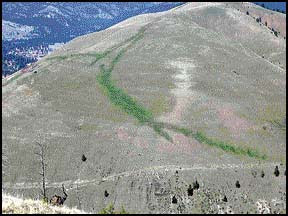 It seems that every few years another issue about the use of aerial fire retardant appears. The latest is that the nitrogen and phosphorous in the retardant produce a condition that encourages cheatgrass, while it has little effect on native grasses.
It seems that every few years another issue about the use of aerial fire retardant appears. The latest is that the nitrogen and phosphorous in the retardant produce a condition that encourages cheatgrass, while it has little effect on native grasses.The photo from the Missoulian apparently shows green strips of cheatgrass growing in the areas where air tankers dropped retardant on on a fire on Mount Jumbo near Missoula on July 4, 2006.
According to the story in the Missoulian:
"According to preliminary results, the retardant's fertilizerlike nutrients significantly increased cheatgrass and tumbleweed mustard, both exotic annual species, at the expense of native perennial grasses on the mountainside.
The invaders benefit from the jolt of nitrogen and phosphorous in the slurry, which native and exotic perennials largely ignore because they are accustomed to nutrient-poor soils.
Cheatgrass and tumbleweed mustard didn't spread where the fire burned alone, but they exploded in areas that were burned and hit with retardant, the study found.
The two invaders have spread from 51 percent to 88 percent on Mount Jumbo since the retardant was dropped, although two perennial invaders, spotted knapweed and Dalmation toadflax, decreased.
The Fourth of July fire burned about 320 acres and fire retardant was dropped on about 12 acres of Mount Jumbo, where noxious weeds have become widespread over the past 20 years.
The two-year study, which is to be completed next spring, is being conducted by Besaw and Giles Thelan, a research specialist at UM's plant ecology laboratory."




No comments:
Post a Comment